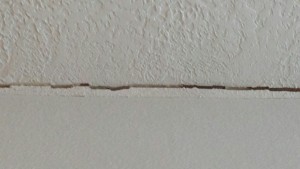You have just moved into your beautiful new barndominium, shouse or post frame home. Your drywall was painted and looked perfect for months and then you start to see seams cracking and screw heads popping through. Our first inclination is to blame whoever installed it. It is possible drywall was installed incorrectly leading to screw pops and seams cracking, however, it may be good to understand why drywall seams crack or screws pop. Many of them are not drywall installation process related.
NATHAN in INDIANAPOLIS writes:
“Do you see much movement in post frame homes…..that causes drywall settlement cracks, or a higher rate of nail pops in drywall?”
Drywall issues in post frame buildings can occur from several reasons – lack of an adequate footing thickness and/or diameter (rarely are concrete cookies adequate); base of column footing not below frost line; poorly prepared site (have to get rid of clay and prevent ground water from flowing under building); columns and wall girts not engineered to limit deflection.
 Where two sheets of drywall meet, this seam is your wall’s weakest point. Drywall tapers spread mud and tape on joints to give strength to this area and then add layers of drywall mud to feather seams smooth to the rest of the wall. When a barndominium settles or walls move, drywall seams may crack if there is a “weak link”. One reason for cracking is because the wrong drywall mud type was used to tape drywall seams. Some drywall mud has more adhering ability and is intended to be used in the drywall taping step whereas other types of mud should only be used in finishing. Other drywall mud products are intended only for second or third coats. Some drywall tapers say mesh tape should never be used because it is not as strong as paper tape. Other drywall tapers say mesh tape is fine as long as it is used with quick setting drywall mud.
Where two sheets of drywall meet, this seam is your wall’s weakest point. Drywall tapers spread mud and tape on joints to give strength to this area and then add layers of drywall mud to feather seams smooth to the rest of the wall. When a barndominium settles or walls move, drywall seams may crack if there is a “weak link”. One reason for cracking is because the wrong drywall mud type was used to tape drywall seams. Some drywall mud has more adhering ability and is intended to be used in the drywall taping step whereas other types of mud should only be used in finishing. Other drywall mud products are intended only for second or third coats. Some drywall tapers say mesh tape should never be used because it is not as strong as paper tape. Other drywall tapers say mesh tape is fine as long as it is used with quick setting drywall mud.
Drywall corner bead will at times crack as well. One reason is when corner bead was installed it may not have been installed to maximize strength. There are different types of corner beads and various installations. If screws were used there may have been too few. If vinyl bead was used with spray adhesive, perhaps not enough glue was used. Different drywall tapers and hangers have different opinions as to what process is strongest. Generally most feel the “tape on” corner bead is strongest and least prone to cracking.
Another common drywall problem is popped screws where you can see what looks like a screw head showing through paint. This usually occurs within the first year after a drywall job has been completed. Drywall screws are used to secure drywall to framing below. Screw head puts pressure against drywall’s paper surface. If the screw head goes too deep and busts through paper into the gypsum layer below, it no longer has holding power. When installing drywall, drywall hangers will at times use construction adhesive on framing below and then use drywall screws to hold sheet until glue has time to dry. When this is done it reduces the number of screw pops. However, this is not a fix-all.
This being said, drywall tape’s strength is limited. Construction adhesive helps to hold sheets in place but fasteners, drywall tape and corner bead all have limited strength. If a barndominium settles and walls move to any great degree, no amount of tape or glue will keep it from cracking.
When cracks develop in a barndominium usually they run along high stress areas. High stress areas include areas above doorways and windows and over beams spanning long distances. If any part of your barndominium was built on improperly compacted fill it will have a greater possibility of settling. Most new barndominiums will settle some within the first year. Good drywall techniques can limit occurrence of cracks and screw pops, however cannot cure inadequate structural design.






